Discover 50 hidden attractions, cool sights, and unusual things to do in Ireland. Don't miss out on these must-see attractions: Dublin Castle (Dublin), O'Connell Street (Dublin) or Science Gallery (Dublin).
Below, you can find the list of the most amazing places you should visit in Ireland.
Table of Contents
Dublin Castle, Dublin
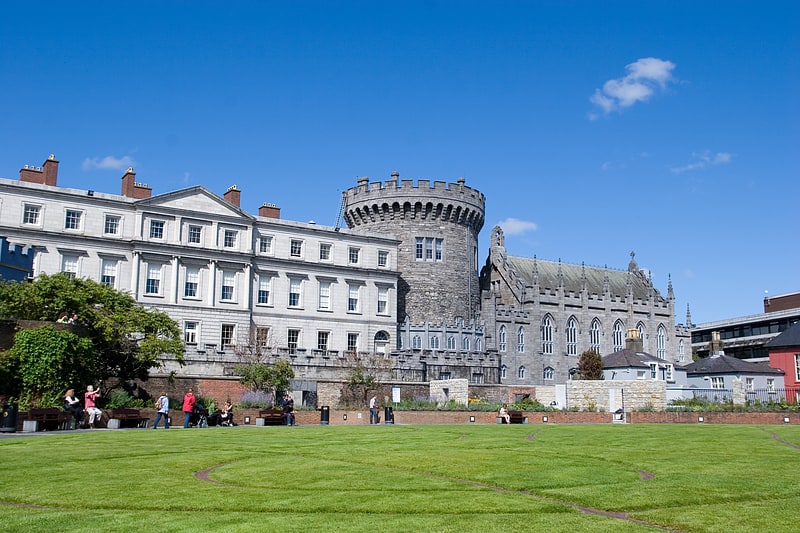
Castle in Dublin, Ireland. Dublin Castle is a major Irish government complex, conference centre, and tourist attraction, of significant historical importance. It is located off Dame Street in central Dublin.
Until 1922 it was the seat of the British government's administration in Ireland. Most of the current construction dates from the 18th century, though a castle has stood on the site since the days of King John, the first Lord of Ireland. The Castle served as the seat of English, then later British, government of Ireland under the Lordship of Ireland (1171–1541), the Kingdom of Ireland (1541–1800), and the United Kingdom of Great Britain and Ireland (1800–1922).
After the signing of the Anglo-Irish Treaty in December 1921, the complex was ceremonially handed over to the newly formed Provisional Government led by Michael Collins. It now hosts the inauguration of each President of Ireland and various State receptions.
The castle was built by the dark pool ("Dubh Linn") which gave Dublin its name. This pool lies on the lower course of the River Poddle before its confluence with the River Liffey; when the castle was built, the Liffey was much wider, and the castle was effectively defended by both rivers. The Poddle today runs under the complex.[1]
Address: Dublin, Dame Street
O'Connell Street, Dublin
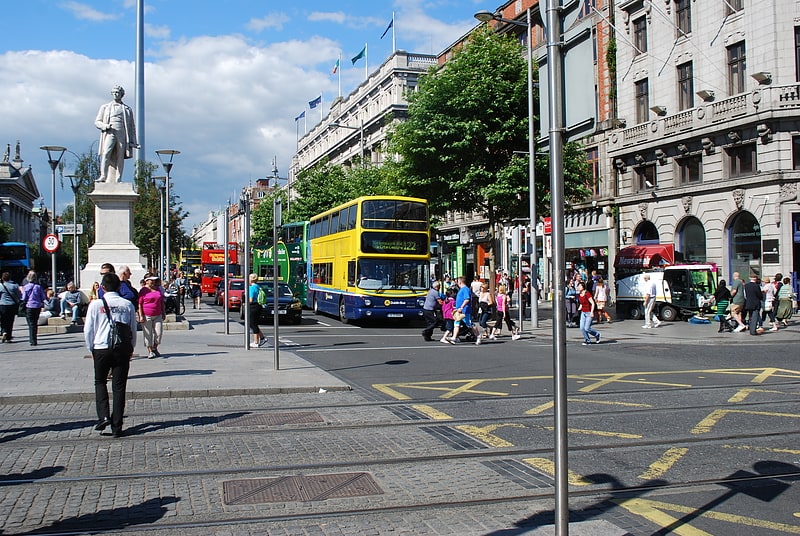
Thoroughfare in Dublin, Republic of Ireland. O'Connell Street is a street in the centre of Dublin, Ireland, running north from the River Liffey. It connects the O'Connell Bridge to the south with Parnell Street to the north and is roughly split into two sections bisected by Henry Street. The Luas tram system runs along the street.
During the 17th century, it was a narrow street known as Drogheda Street, named after Henry Moore, Earl of Drogheda. It was widened in the late 18th century by the Wide Streets Commission and renamed Sackville Street (Sráid Saicfil) after Lionel Sackville, 1st Duke of Dorset. In 1924, it was renamed in honour of Daniel O'Connell, a nationalist leader of the early 19th century, whose statue stands at the lower end of the street, facing O'Connell Bridge.
The street has played an important part in Irish history and features several important monuments, including statues of O'Connell and union leader James Larkin, and the Spire of Dublin. It formed the backdrop to one of the 1913 Dublin lock-out gatherings, the 1916 Easter Rising, the Irish Civil War of 1922, the destruction of Nelson's Pillar in 1966 and the Dublin Riots in 2006. In the late 20th century, a comprehensive plan was begun to restore the street to its original 19th-century character.[2]
Address: O'Connell Street, Dublin (Northside)
Science Gallery, Dublin
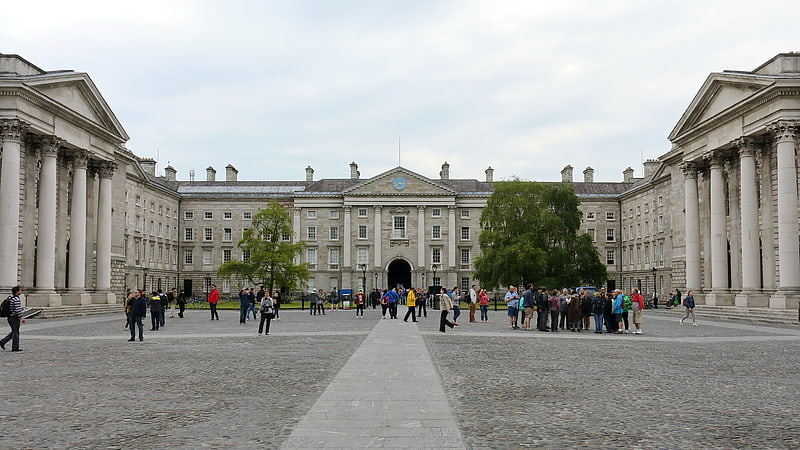
Art institute in Dublin, Republic of Ireland. Science Gallery is an international group of public science centres, developed from a concept by a group connected to Trinity College Dublin, Ireland. The first Science Gallery was opened in 2008 and housed in the Naughton Institute at Trinity College.
Each gallery is operated by a major academic institution in partnership with Science Gallery International and each holds various artistic exhibitions and lectures with a view to science outreach and art-science collaborations. Unlike most science centres, they have no permanent collections, but rather a series of three to four temporary exhibitions each year. Five galleries were established by the end of 2020, with several more planned.[3]
Address: Pearse St, Dublin (Southside)
Galway City Museum, Galway
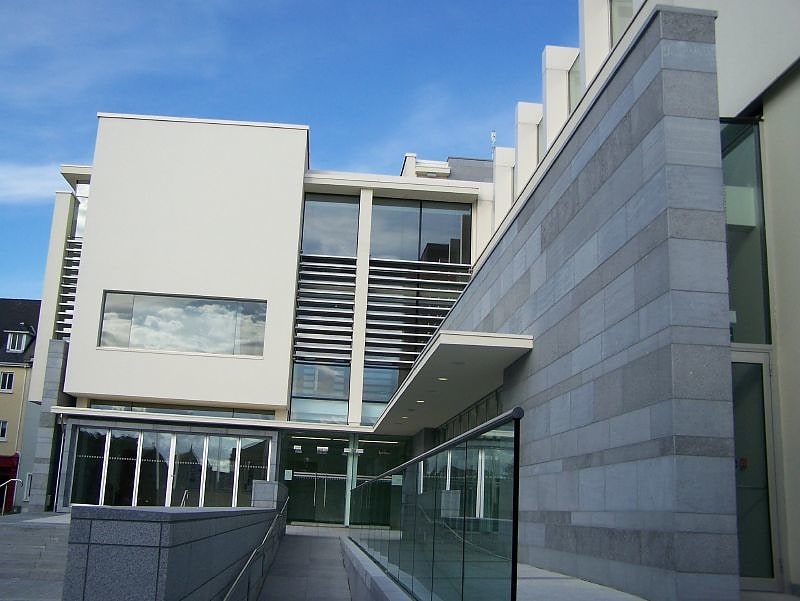
Museum in Galway, Ireland. Galway City Museum is a museum in Galway City, County Galway, Ireland. It was founded on 29 July 2006, and is located beside the Spanish Arch.[4]
Address: Spanish Parade, H91 CX5P Galway
Ross Castle, Killarney National Park
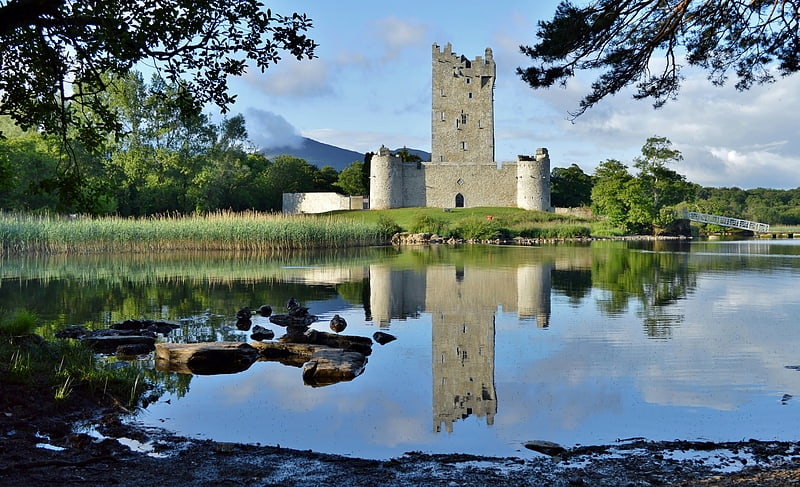
Tours of 15th-century tower and gardens. Ross Castle is a 15th-century tower house and keep on the edge of Lough Leane, in Killarney National Park, County Kerry, Ireland. It is the ancestral home of the Chiefs of the Clan O'Donoghue, later associated with the Brownes of Killarney.
The castle is operated by the Office of Public Works, and is open to the public seasonally with guided tours.[5]
Address: Ross Castle Ross Road, Killarney National Park
Crawford Art Gallery, Cork
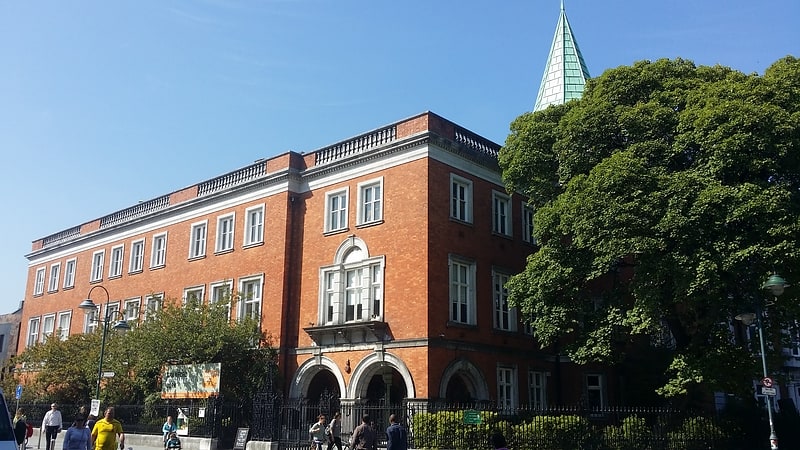
Art gallery in Cork, Ireland. The Crawford Art Gallery is a public art gallery and museum in the city of Cork, Ireland. Known informally as the Crawford, it was designated a 'National Cultural Institution' in 2006. It is "dedicated to the visual arts, both historic and contemporary", and welcomed 265,438 visitors in 2019.[6]
Address: Emmett Pl, Cork
Muckross House, Killarney National Park
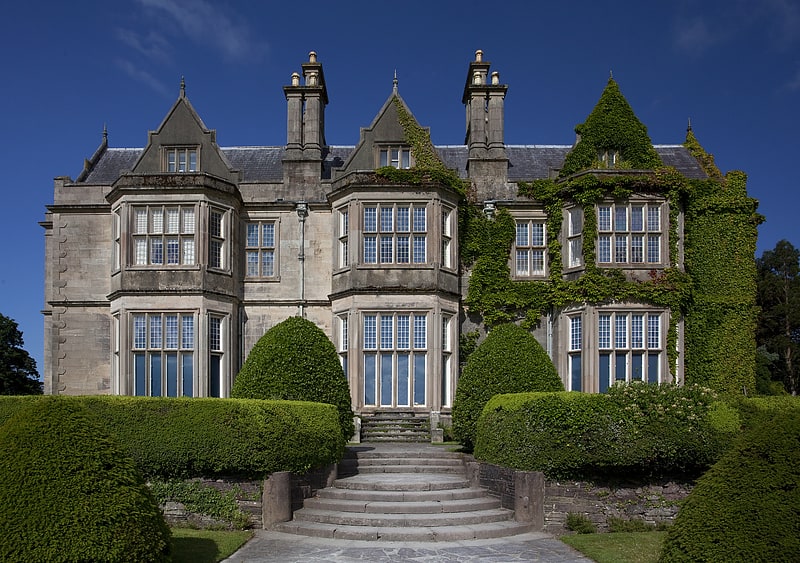
19th-century lakeside mansion and gardens. Muckross House is located on the small Muckross Peninsula between Muckross Lake and Lough Leane, two of the lakes of Killarney, 6 kilometres from the town of Killarney in County Kerry, Ireland. In 1932 it was presented by William Bowers Bourn and Arthur Rose Vincent to the Irish nation. It thus became the first National Park in the Irish Free State and formed the basis of the present day Killarney National Park.[7]
Address: The Killarney National Park, V93 EW28 Killarney National Park
Saint Fin Barre's Cathedral, Cork
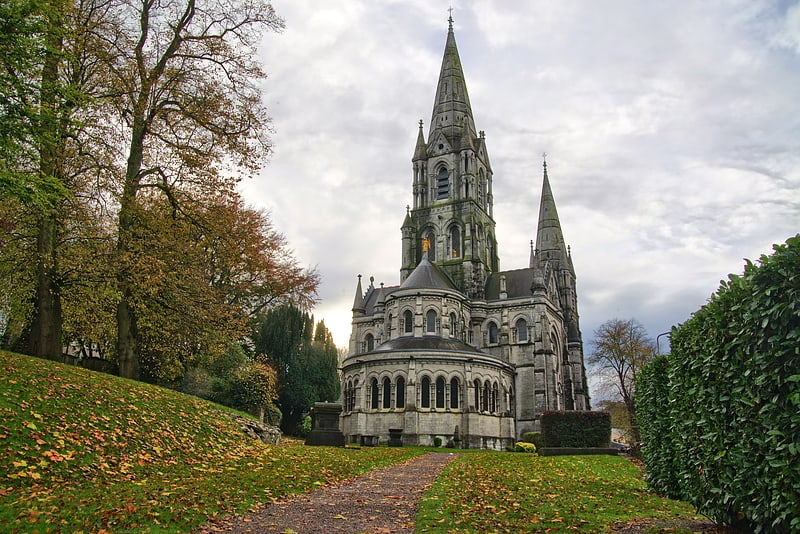
Victorian Gothic edifice with spires. Saint Fin Barre's Cathedral is a Gothic Revival three-spire Church of Ireland cathedral in the city of Cork. It is located on the south bank of the River Lee and dedicated to Finbarr of Cork, patron saint of the city. Formerly the sole cathedral of the Diocese of Cork, it is now one of three co-cathedrals in the United Dioceses of Cork, Cloyne and Ross in the ecclesiastical province of Dublin. Christian use of the site dates back 7th-century AD when, according to local lore, Finbarr of Cork founded a monastery. The original building survived until the 12th century, when it either fell into disuse or was destroyed during the Norman invasion of Ireland. Around 1536, during the Protestant Reformation, the cathedral became part of the established church, later known as the Church of Ireland. The previous building was constructed in the 1730s, but was widely regarded as plain and featureless.
The cathedral's demolition and rebuild was commissioned in the mid-19th century by an Anglican church intent on strengthening its hand after the reforms of penal law. Work began in 1863, and resulted in the first major commissioned project for the Victorian architect William Burges, who designed most of the cathedral's architecture, sculpture, stained glass, mosaics and interior furniture. Saint Fin Barre's foundation stone was laid in 1865. The cathedral was consecrated in 1870 and the limestone spires completed by October 1879.
Saint Fin Barre's is mostly built from local stone sourced from Little Island and Fermoy. The exterior is capped by three spires: two on the west front and above where the transept crosses the nave. Many of the external sculptures, including the gargoyles, were modelled by Thomas Nicholls. The entrances contain the figures of over a dozen biblical figures, capped by a tympanum showing a Resurrection scene.[8]
Address: Bishop St, Cork
King John's Castle, Limerick

13th-century riverside fortress. King John's Castle also known as Limerick Castle is a 13th-century castle located on King's Island in Limerick, Ireland, next to the River Shannon. Although the site dates back to 922 when the Vikings lived on the Island, the castle itself was built on the orders of King John in 1200. One of the best preserved Norman castles in Europe, the walls, towers and fortifications remain today and are visitor attractions. The remains of a Viking settlement were uncovered during archaeological excavations at the site in 1900.[9]
Address: Nicholas Street, Limerick
Cathedral of Our Lady Assumed into Heaven and St Nicholas, Galway
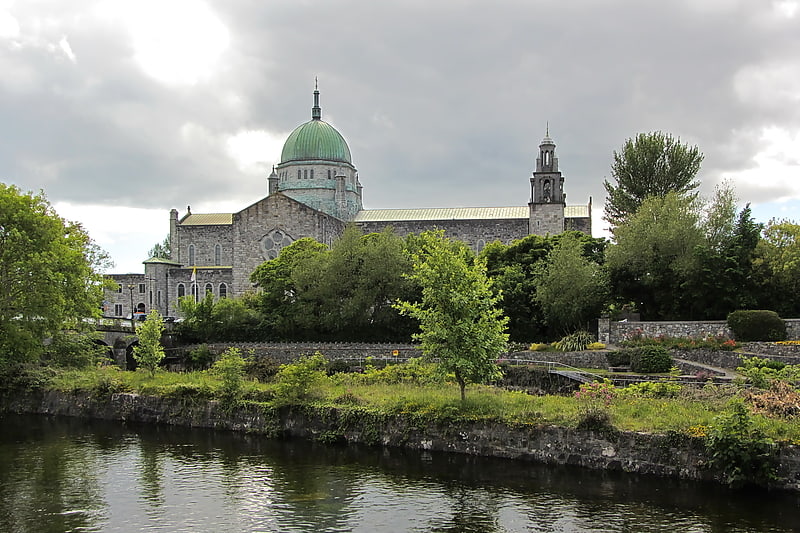
Expansive green-domed Catholic cathedral. The Cathedral of Our Lady Assumed into Heaven and St Nicholas, commonly known as Galway Cathedral, is a Roman Catholic cathedral in Galway, Ireland, and one of the largest and most impressive buildings in the city.
Construction began in 1958 on the site of the old city prison. It was completed in 1965, making it the last great stone cathedral to be built in Europe. It was dedicated, jointly, to Our Lady Assumed into Heaven and to St. Nicholas.[10]
Address: University and Gaol Rds., Galway
English Market, Cork

Produce market in Cork, Republic of Ireland. The English Market is a municipal food market in the center of Cork city, Ireland. It stretches from Princes Street to the Grand Parade, and combines Princes Street Market and Grand Parade Market. The market is regarded for both its mid-19th century architecture and locally produced artisan food.
The market has become a tourist attraction, has developed an international reputation, and has been described by chef Rick Stein as the "best covered market in the UK and Ireland".[11]
Address: Princes St, Cork
Spanish Arch, Galway
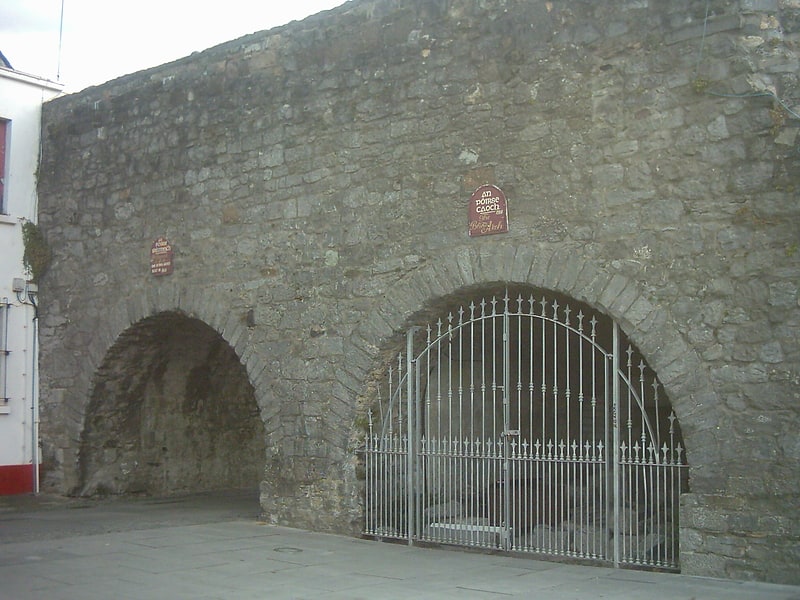
Historical landmark in Galway, Ireland. The Spanish Arch and the Caoċ Arch in Galway city, Ireland, are two remaining arches on the Ceann an Bhalla.[12]
Address: Spanish Arch, Galway
Kilkenny Castle, Kilkenny
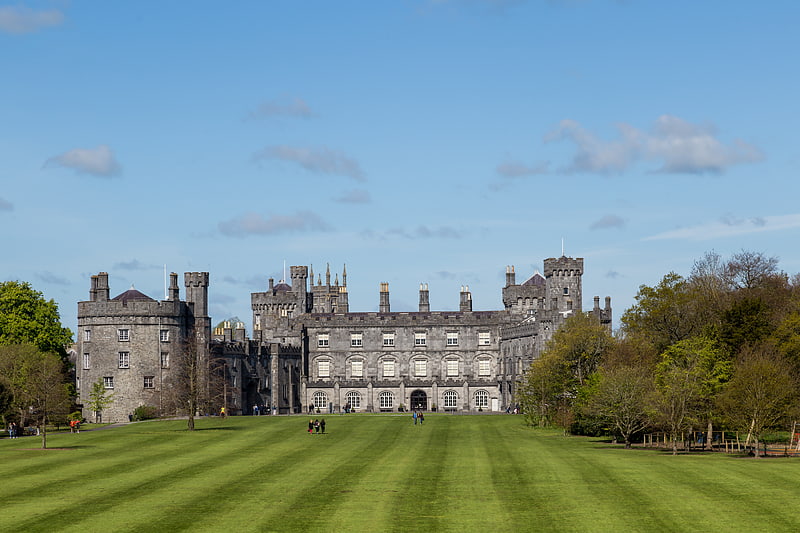
Tours of restored 12th-century fortress. Kilkenny Castle is a castle in Kilkenny, Ireland built in 1195 to control a fording-point of the River Nore and the junction of several routeways. It was a symbol of Norman occupation and in its original thirteenth-century condition it would have formed an important element of the defences of the town with four large circular corner towers and a massive ditch, part of which can still be seen today on the Parade.
The property was transferred to the people of Kilkenny in 1967 for £50 and the castle and grounds are now managed by the Office of Public Works. The gardens and parkland adjoining the castle are open to the public. The Parade Tower is a conference venue. Awards and conferring ceremonies of the graduates of the Kilkenny Campus of National University of Ireland, Maynooth have been held there since 2002.[13]
Address: Caisleán Chill Chainnigh, R95 YRK1 Kilkenny
Malahide Castle, Malahide
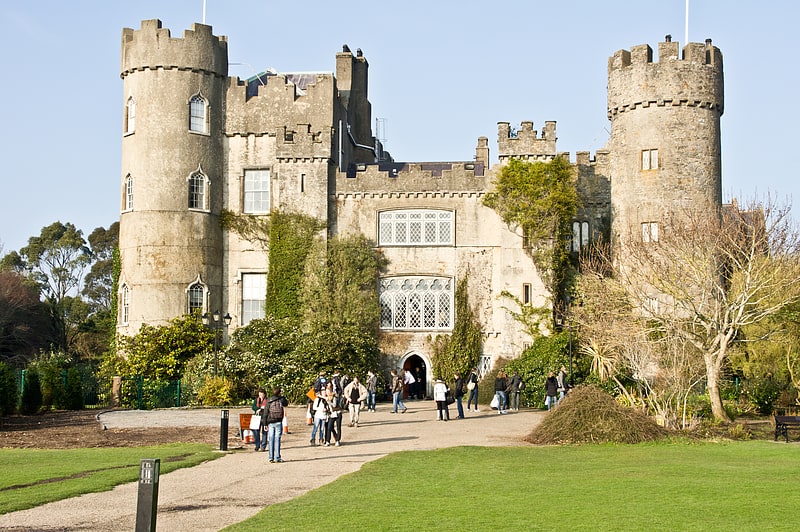
Well-kept, 12th-century bastion. Malahide Castle, parts of which date to the 12th century, lies close to the village of Malahide, nine miles north of central Dublin in Ireland. It has over 260 acres of remaining parkland estate, forming the Malahide Demesne Regional Park.[14]
Address: Malahide Demesne, Malahide
St Canice's Cathedral, Kilkenny
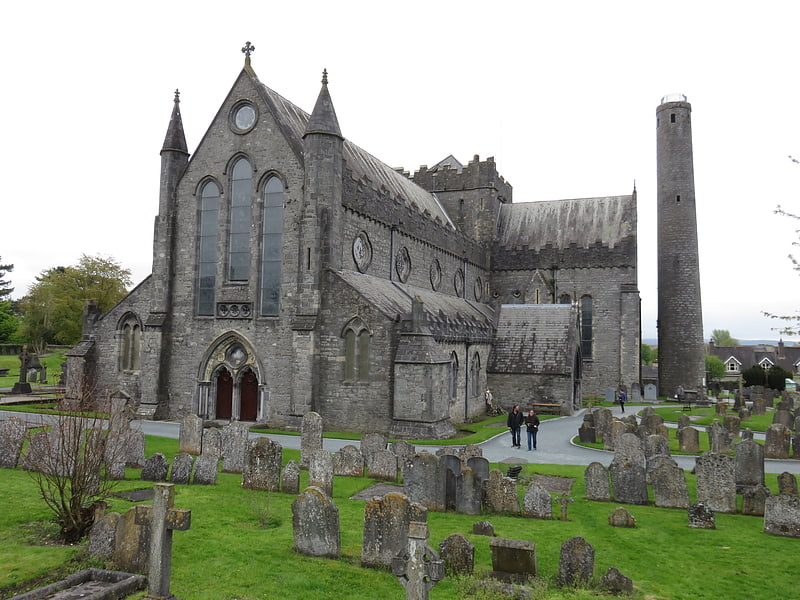
Catholic cathedral and 9th-century tower. St Canice's Cathedral, also known as Kilkenny Cathedral, is a cathedral of the Church of Ireland in Kilkenny city, Ireland. It is in the ecclesiastical province of Dublin. Previously the cathedral of the Diocese of Ossory, it is now one of six cathedrals in the United Dioceses of Cashel and Ossory.[15]
Address: The Close, Coach Rd, R95 V63H Kilkenny
The Milk Market, Limerick
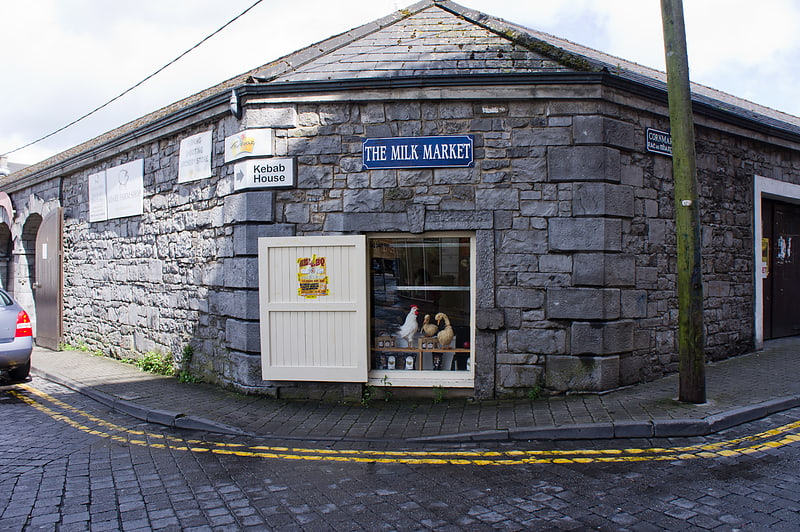
The Milk Market is a food market located on Mungret Street, Limerick, Ireland. Despite the name, the market has diversified over the years from its initial purpose and now sells a wide variety of foodstuffs, much of which is produced locally. The market is one of the oldest in Ireland. The flagship market day is the Saturday food market, however, markets are also held on Fridays and Sundays.[16]
Address: The Milk Market Market House, Mungret Street, Limerick
Lakes of Killarney, Killarney National Park
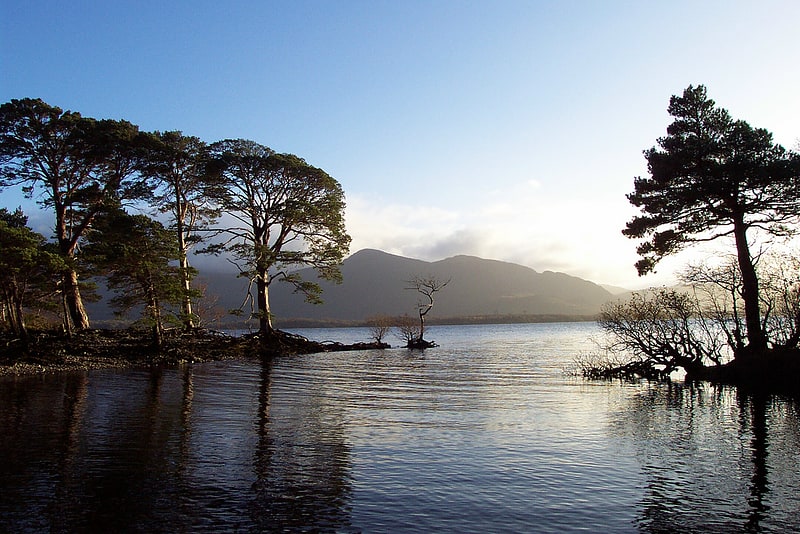
Lake. The Lakes of Killarney are a scenic attraction located in Killarney National Park near Killarney, County Kerry, in Ireland. They consist of three lakes - Lough Leane, Muckross Lake and Upper Lake.[17]
Limerick Museum, Limerick
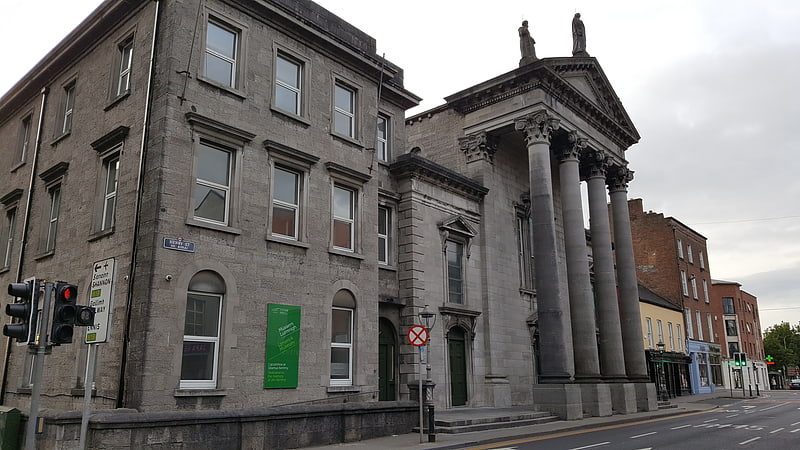
Limerick Museum, previously known as the Jim Kemmy Municipal Museum, is a city museum in Limerick, Ireland.[18]
Address: 97 Henry Street, V94 V4Y2 Limerick
Muckross Abbey, Killarney
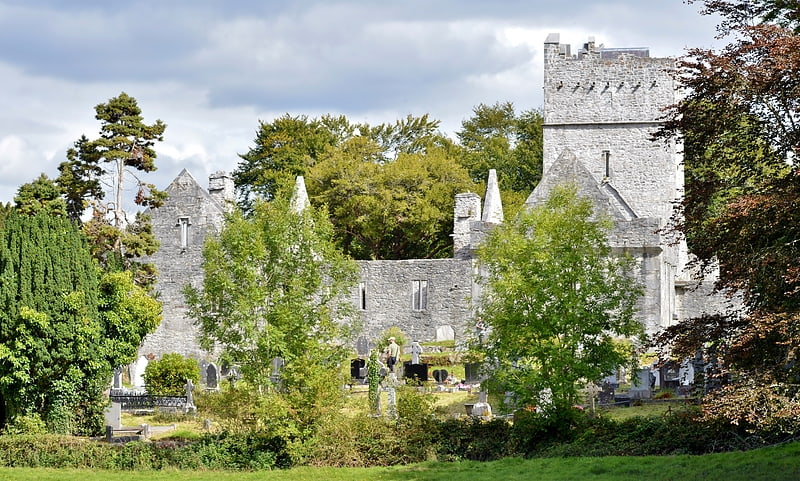
Historic site with a courtyard. Muckross Abbey is one of the major ecclesiastical sites, found in the Killarney National Park, County Kerry, Ireland. It was founded in 1448 as a Franciscan friary for the Observantine Franciscans by Donal McCarthy Mor.
It has had a violent history and has been damaged and reconstructed many times. The friars were often subjected to raids by marauding groups and were persecuted by Cromwellian forces under Lord Ludlow. Today the abbey is largely roofless although, apart from this, is generally quite well preserved. Its most striking feature is a central courtyard, which contains a large yew tree and is surrounded by a vaulted cloister.
In the 17th and 18th centuries, it became the burial place for prominent County Kerry poets O'Donoghue, Ó Rathaille and Ó Súilleabháin, while Piaras Feiritéar is buried in the graveyard just outside.[19]
Rock of Cashel, Cashel
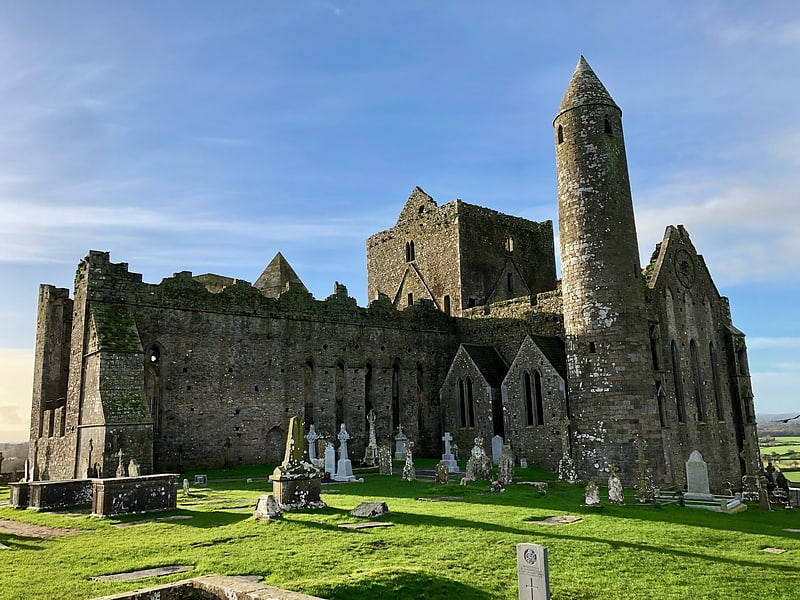
Limestone hill with Medieval buildings. The Rock of Cashel, also known as Cashel of the Kings and St. Patrick's Rock, is a historic site located at Cashel, County Tipperary, Ireland.[20]
Address: Carraig Phádraig, Cashel
Newgrange, Brú Na Bóinne Archaeological Park
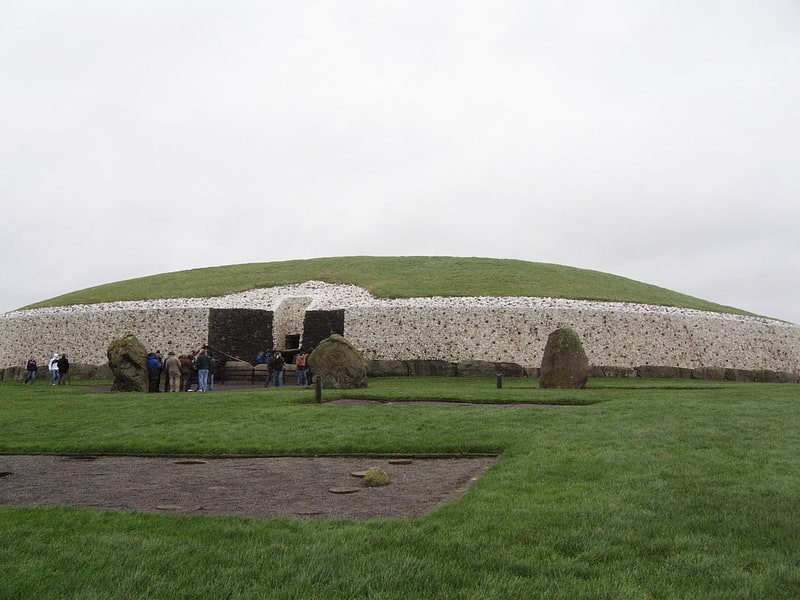
Neolithic monuments and visitor centre. Newgrange is a prehistoric monument in County Meath in Ireland, located on a rise overlooking the River Boyne, 8 kilometres west of Drogheda. It is an exceptionally grand passage tomb built during the Neolithic Period, around 3200 BC, making it older than Stonehenge and the Egyptian pyramids. It is aligned on the winter solstice sunrise. Newgrange is the main monument in the Brú na Bóinne complex, a World Heritage Site that also includes the passage tombs of Knowth and Dowth, as well as other henges, burial mounds and standing stones.
Newgrange consists of a large circular mound with an inner stone passageway and cruciform chamber. Burnt and unburnt human bones, and possible grave goods or votive offerings, were found in this chamber. The mound has a retaining wall at the front, made mostly of white quartz cobblestones, and it is ringed by engraved kerbstones. Many of the larger stones of Newgrange are covered in megalithic art. The mound is also ringed by a stone circle. Some of the material that makes up the monument came from as far as the Mournes and Wicklow Mountains. There is no agreement about its purpose, but it is believed it had religious significance. It is aligned so that the rising sun on the winter solstice shines through a 'roofbox' above the entrance and floods the inner chamber. Several other passage tombs in Ireland are aligned with solstices and equinoxes, and Cairn G at Carrowkeel has a similar 'roofbox'. Newgrange shares similarities with some other Neolithic monuments in Western Europe; especially Gavrinis in Brittany, which has a similar preserved facing and large carved stones, Maeshowe in Orkney, with its large corbelled chamber, and Bryn Celli Ddu in Wales.
Its initial period of use lasted about 1,000 years. Newgrange then gradually became a ruin, although the area continued to be a site of ritual activity. It featured in Irish mythology and folklore, in which it is said to be a dwelling of the deities, particularly The Dagda and his son Aengus. Antiquarians first began its study in the seventeenth century, and archaeological excavations began in the twentieth century. Archaeologist Michael J. O'Kelly led the most extensive of these from 1962 to 1975 and also reconstructed the front of the monument, a reconstruction that is controversial and disputed. This included an inward-curving dark stone wall to ease visitor access. Newgrange is a popular tourist site and, according to archaeologist Colin Renfrew, is "unhesitatingly regarded by the prehistorian as the great national monument of Ireland" and as one of the most important megalithic structures in Europe.[21]
Charles Fort, Kinsale
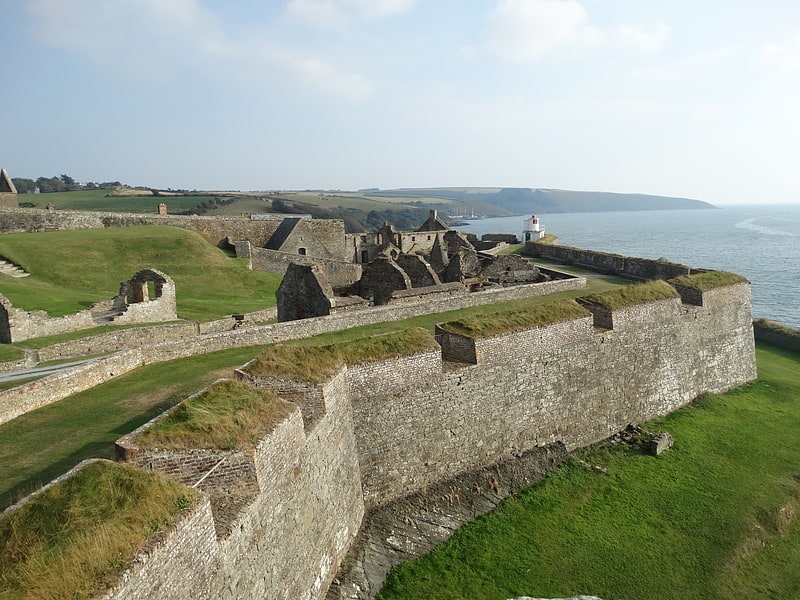
Star-shaped 17th-century fort. Charles Fort is a trace italien fortification, a bastion fort with one section of the outer wall built in star fashion. It is located on the water's edge, at the southern end of the village of Summer Cove, on Kinsale harbour, County Cork, Ireland. First completed in 1682, Charles Fort was sometimes historically referred to as the "new fort" - to contrast with James' Fort which had been built on the other side of Kinsale harbour before 1607. The fort is now operated as a heritage tourism site by the Heritage Ireland arm of the Office of Public Works.[22]
Address: Charles Fort Charles Fort Charles Fort Summer Cove, Kinsale
Carrauntoohil, Killarney
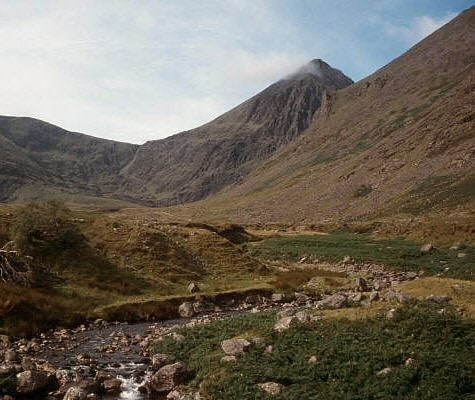
Mountain in the Republic of Ireland. Carrauntoohil or Carrauntoohill is the highest mountain on the island of Ireland at 1,038.6 metres. It is on the Iveragh Peninsula in the Reeks District in County Kerry, close to the centre of Ireland's highest mountain range, MacGillycuddy's Reeks. Carrauntoohil is composed mainly of sandstone, whose glaciation produced distinctive features on the mountain such as the Eagle's Nest corrie and some deep gullies and sharp arêtes in its east and northeastern faces that are popular with rock and winter climbers.
As Ireland's highest mountain, Carrauntoohil is popular with mountain walkers, who most commonly ascend via the Devil's Ladder route; however, Carrauntoohil is also climbed as part of longer mountain walking routes in the MacGillycuddy's Reeks range, including the 15-kilometre (9+1⁄2 mi) Coomloughra Horseshoe or the 26-kilometre (16 mi) MacGillycuddy's Reeks Ridge Walk of the entire mountain range. Carrauntoohil, and most of the range, is held in private ownership and is not part of any Irish national park; however, reasonable access is granted to the public for recreational use.[23]
Bray Head, Bray
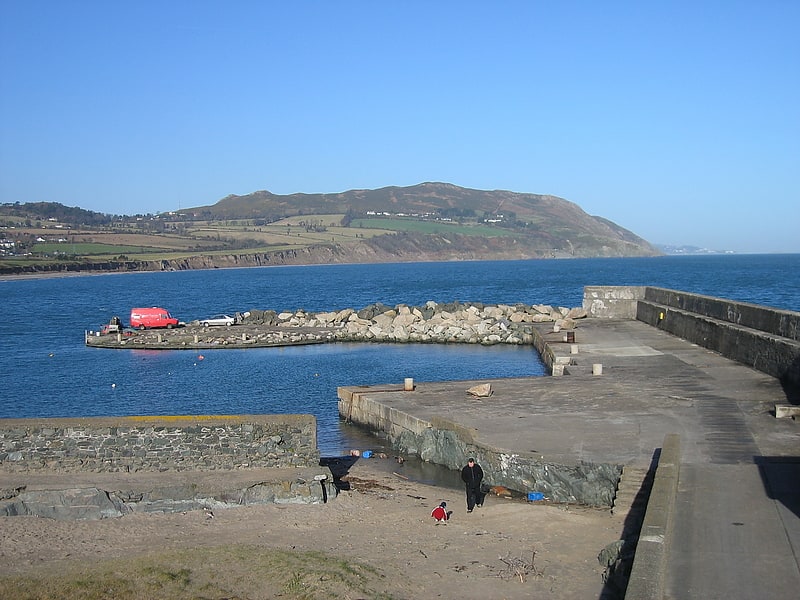
A promenade leads to a hill with a cross. Bray Head is a 241 m hill and headland located in northern County Wicklow, Ireland, between the towns of Bray and Greystones. It forms part of the Wicklow Mountains and is a popular spot with hillwalkers. At the top of the head is a concrete cross which was placed there in 1950 during the holy year. Every Good Friday, hundreds of local people climb to the top of the head in a Good Friday procession marking the stations of the Cross as they go along, with the final station being held at the holy year cross. The headland and adjacent lands were designated under a Special Amenity Area Order in March 2008.
The most direct way to reach the cross at the top (about 190m above sea level) is via an ascending footpath that begins just outside the free car park on the lower, northern slopes, to the south of Bray Esplanade. This is a half-hour walk for a fit person. The footpath, after the initial section with cut steps, is a rough path formed by rainwater and ascending through natural woodland. A more gradual route can be taken from the Southern Cross, by Bray Golf Club, which is easier underfoot. There is also a route which ascends from the Greystones side of the cliff walk; this route leads quite directly up the east side of the hill and as a result is quite steep, Upon reaching the top you can then walk the path along to the cross.
The Dublin-Wicklow railway line runs outside of Bray Head along the coast, sometimes travelling within feet of the cliffs. This line, designed by Isambard Kingdom Brunel, is referred to as Brunel's Folly, due to the ongoing maintenance costs associated with maintaining a cliff-face line. The line had to be diverted on three occasions in 1876, 1879, and 1917. A serious accident occurred on 9 August 1867 when a passenger train derailed on nearby Brandy Hole Viaduct, causing the deaths of two passengers. The rail trip between Dublin and Bray Daly railway station, the nearest station to Bray Head, takes approximately 45 minutes.
On the morning of 14 April 2012 a waterspout was observed just off the coast of Bray Head.
The slate sea-cliffs at Bray Head have been established as a minor rock-climbing location since the 1970s, though a few of the climbs were originally recorded in the 1940s. The 2009 guidebook lists 27 single-pitch climbs, generally in the lower grades, up to HVS.[24]
Address: Bray Head, Bray
St Mary's Cathedral, Kilkenny

Stately 19th-century Catholic church. St Mary’s is the cathedral church of the Roman Catholic Diocese of Ossory. It is situated on James’s Street, Kilkenny, Ireland.
Saint Mary’s was designed by William Deane Butler (c.1794-1857). He was chosen by Bishop William Kinsella (1793-1845) who instigated the building of St. Mary’s in February 1842. Work began in April 1843 and finished in 1857. On Sunday 4 October 1857, St. Mary’s had its grand opening, which consisted of a two-and-three-quarter hour ceremony that began at 6.15am. The cost of the building is estimated to have been £25,000.
St. Mary’s is made from cut-limestone which was sourced locally. The cathedral has a cruciform plan and its style is described as ‘Early English Gothic’. The design is believed to have been based on Gloucester Cathedral in Gloucester, England. It is situated on the highest point in Kilkenny City and is a significant local landmark.
The cathedral is variously referred to as "St Mary’s", "the church of St Kieran" and "the Cathedral of the Assumption".
St. Mary’s has a noted sculpture of the Madonna by Giovanni Maria Benzoni (1809-1873).[25]
Address: James's St, Kilkenny
St Mary's Cathedral, Killarney
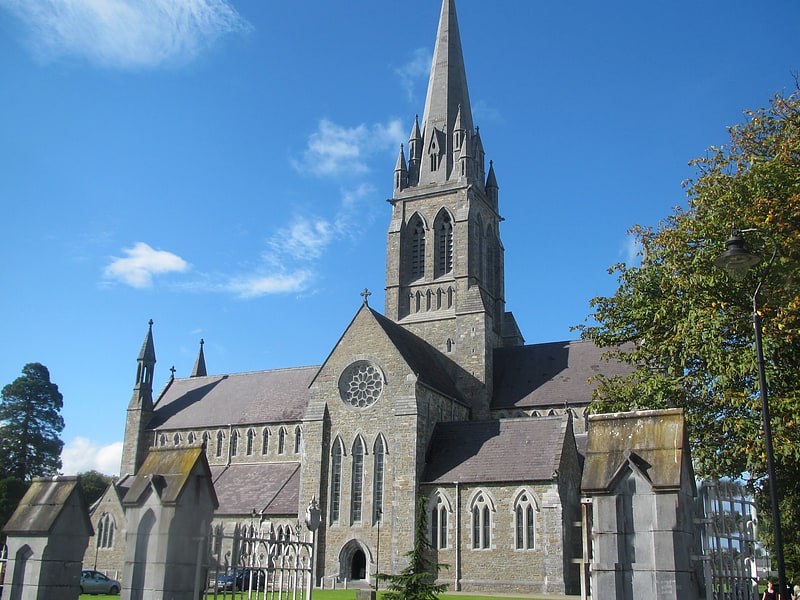
Historical Roman Catholic church. St. Mary's Cathedral, Killarney, is the cathedral church of the Diocese of Kerry situated to the west of Killarney in County Kerry, Ireland.[26]
Address: Saint Mary's Church Cathedral Place, Killarney
Gallarus Oratory, Dingle
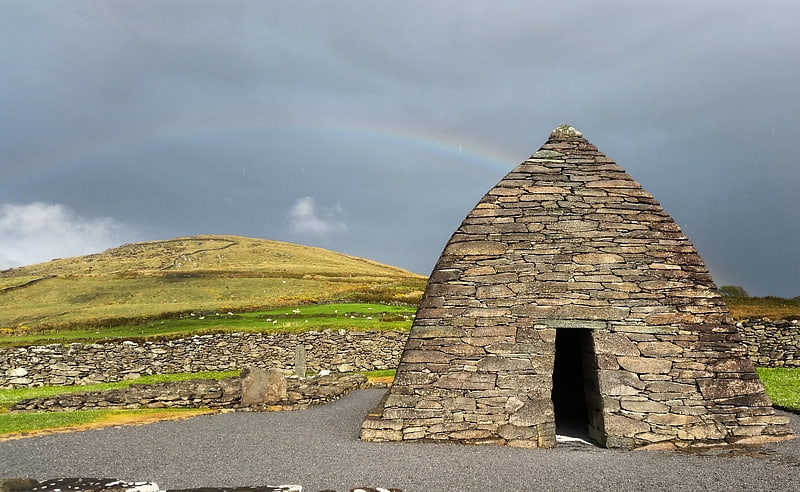
Chapel in the Republic of Ireland. The Gallarus Oratory (Irish: Séipéilín Ghallarais, Gallarus being interpreted as either 'rocky headland' or 'house or shelter for foreigner' is a chapel on the Dingle Peninsula, County Kerry, Ireland. It has been presented variously as an early-Christian stone church by antiquary Charles Smith, in 1756; a 12th century Romanesque church by archaeologist Peter Harbison in 1970; a shelter for pilgrims by the same in 1994. The local tradition prevalent at the time of Charles Smith attributed it to one Griffith More, being a funerary chapel built by him or his family at their burial place.
The oratory overlooks the harbour at Ard na Caithne (formerly also called Smerwick) on the Dingle Peninsula.[27]
Address: 8 km northeast of Ballyferriter on R559, Dingle
St Colman's Cathedral, Cobh
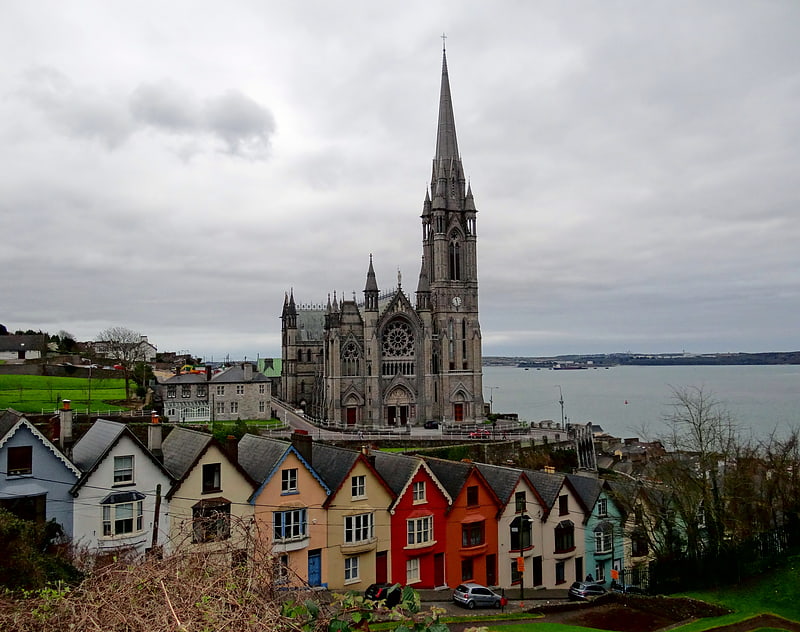
Imposing cathedral made from granite. The Cathedral Church of St Colman, usually known as Cobh Cathedral, or previously Queenstown Cathedral, is a single-spire cathedral in Cobh, Ireland. It is a Roman Catholic cathedral and was completed in 1919. Built on Cathedral Place, it overlooks Cork harbour from a prominent position, and is dedicated to Colmán of Cloyne, patron saint of the Diocese of Cloyne. It serves as the cathedral church of the Diocese.
Construction began in 1868 and was not completed until over half a century later due to increases in costs and revisions of the original plans. With the steeple being 91.4 metres tall (300 ft), the cathedral is the tallest church in Ireland. It was considered to be the second-tallest, behind St John's Cathedral in Limerick which was believed to be 94 metres tall; newer measurements have shown that the St John's spire is in fact 81 metres tall and therefore only the fourth tallest church in Ireland.[28]
Address: Cathedral Terrace, None Cobh
Aillwee Cave, Ballyvaughan
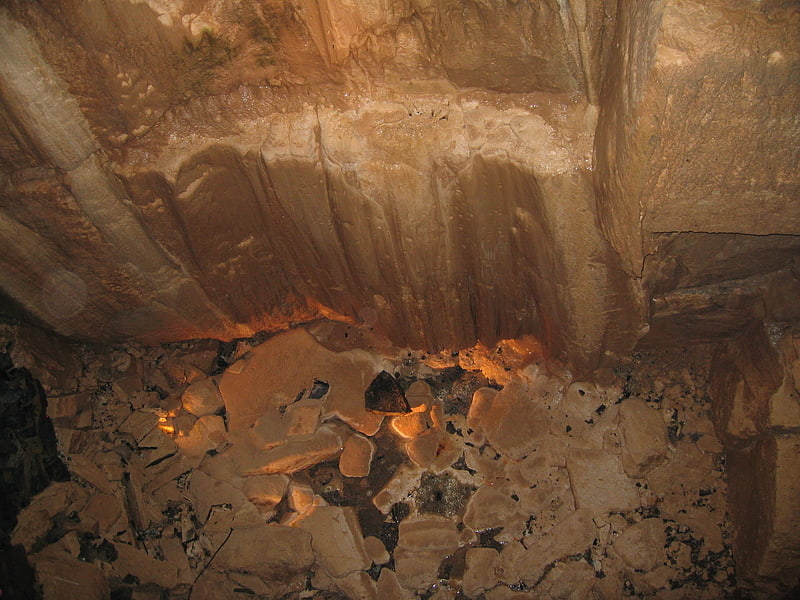
Tourist attraction in Ballyvaughan, Ireland. Aillwee Cave is a cave system in the karst landscape of the Burren in County Clare, Ireland. The name Aillwee is derived from the Irish Aill Bhuí which means "yellow cliff". Privately owned, it forms part of the Aillwee Cave and Birds of Prey Centre attraction.[29]
Reginald's Tower, Waterford
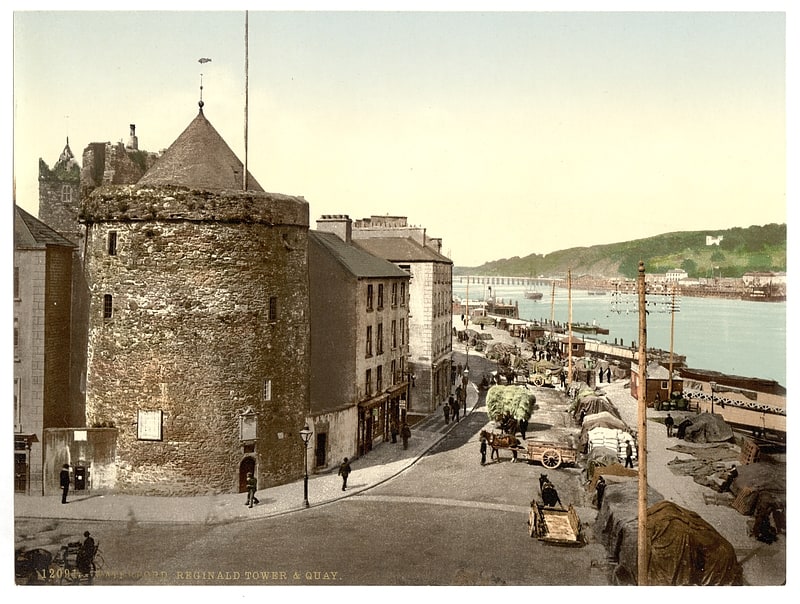
Museum in Waterford, Republic of Ireland. Reginald's Tower is a historic tower in Waterford, Munster, Ireland. It is located at the eastern end of the city quay. The tower has been in usage for different purposes for many centuries and is an important landmark in Waterford and an important remnant of its medieval urban defence system. It is the oldest civic building in Ireland and it is the only urban monument in Ireland to retain a Norse or Viking name.[30]
Address: The Quay, Waterford
Dún Aonghasa, Inis Mór

Clifftop prehistoric stone fort. Dún Aonghasa is the best-known of several prehistoric hill forts on the Aran Islands of County Galway, Republic of Ireland. It lies on Inis Mór, at the edge of a 100-metre-high cliff.
A popular tourist attraction, Dún Aonghasa is an important archaeological site.[31]
Address: Cill Mhuirbhigh, Inis Mór
Carrowmore, Sligo
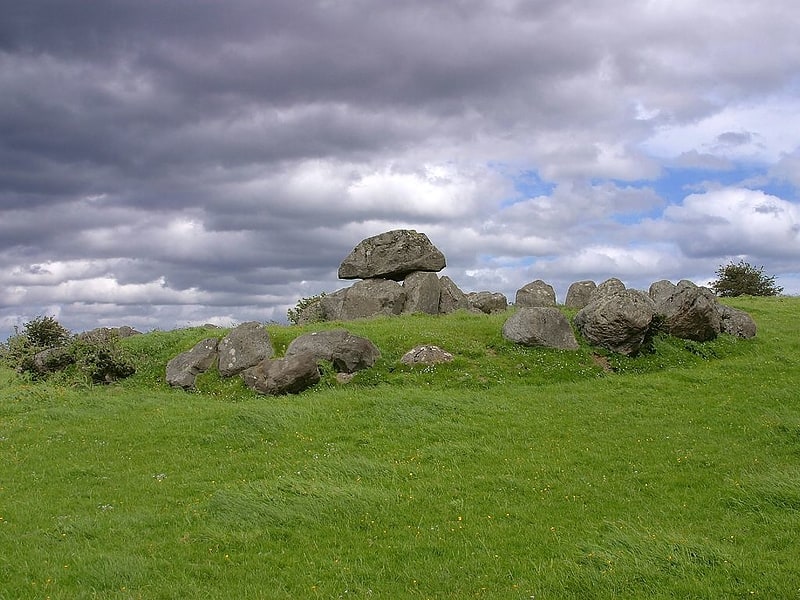
Complex of Megalithic tombs. Carrowmore is a large group of megalithic monuments on the Cúil Iorra Peninsula to the west of Sligo, Ireland. They were built in the 4th millennium BCE, during the Neolithic era. There are thirty surviving tombs, making Carrowmore one of the largest clusters of megalithic tombs in Ireland. It is considered one of the 'big four' along with Carrowkeel, Loughcrew and Brú na Bóinne. Carrowmore is the heart of an ancient ritual landscape which is dominated by the mountain of Knocknarea to the west. It is a protected National Monument.[32]
Address: Carrowmore Visitor Centre, Sligo
Howth Lighthouse, Howth
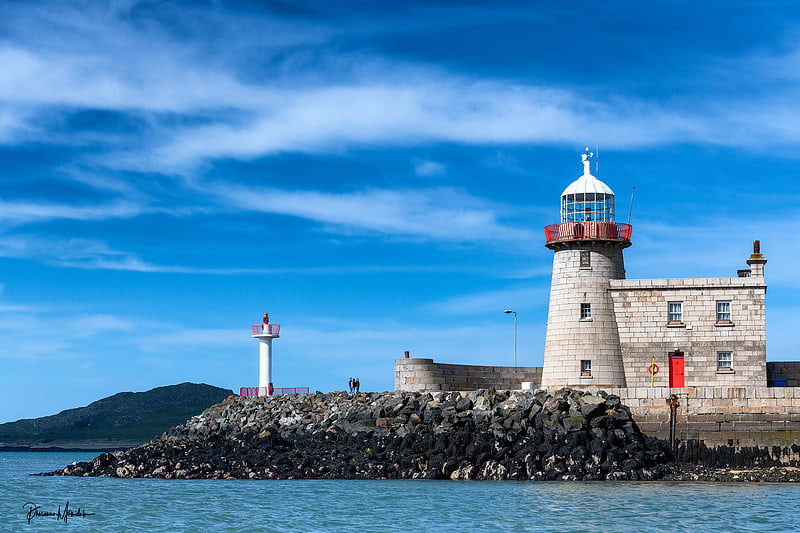
The Harbour lighthouse in Howth is an historic aid to navigation situated on the East pier of the harbour. It was built in the early 19th century to help guide shipping into the newly constructed harbour, which acted as the terminus for the packet service between Ireland and England. In 1982 it was decommissioned and replaced by a modern pole light on an adjacent extension of the pier.[33]
Sligo Abbey, Sligo
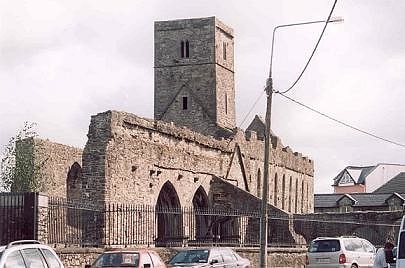
1200s Dominican friary with noted altar. Sligo Abbey was a Dominican convent in Sligo, Ireland, founded in 1253. It was built in the Romanesque style with some later additions and alterations. Extensive ruins remain, mainly of the church and the cloister.[34]
Address: Sligo Abbey Visitor Centre Abbey Street, F91 K796 Sligo
Knowth, Brú Na Bóinne Archaeological Park
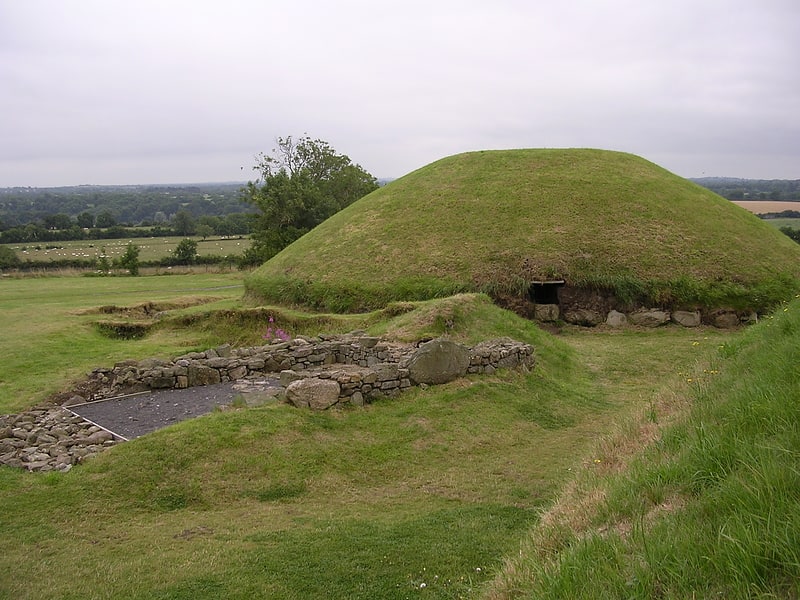
Neolithic site with tombs and rock art. Knowth is a Neolithic passage grave and an ancient monument of the World Heritage Site of Brú na Bóinne located 8.4 km west of Drogheda in Ireland's valley of the River Boyne. It is the largest passage grave of the Brú na Bóinne complex. It consists of a large mound and 17 smaller satellite tombs. The mound is about 12 metres high and 67 metres in diameter, covering roughly a hectare. It contains two passages placed along an east-west line and is encircled by 127 kerbstones, of which three are missing, and four badly damaged.
The large mound has been estimated to date from c. 3200 BC. The passages are independent of each other, leading to separate burial chambers. The eastern passage arrives at a cruciform chamber, not unlike that found at Newgrange, which contains three recesses and basin stones into which the cremated remains of the dead were placed. The right-hand recess is larger and more elaborately decorated with megalithic art than the others, which is typical for Irish passage graves of this type. The western passage ends in an undifferentiated chamber, which is separated from the passage by a sill stone. The chamber seems to have also contained a basin stone which was later removed and is now located about two-thirds down the passageway.[35]
Ashford Castle, Cong
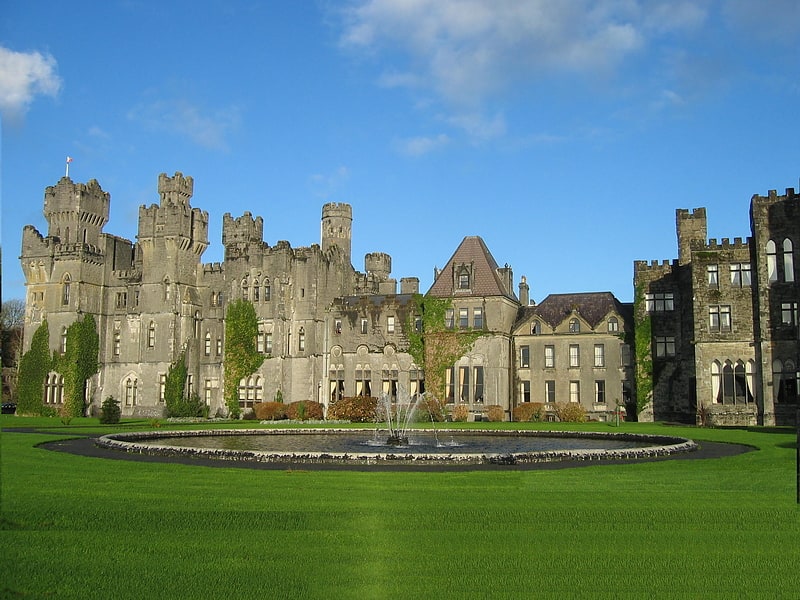
Luxury hotel in the Republic of Ireland. Ashford Castle is a medieval and Victorian castle that has been expanded over the centuries and turned into a five star luxury hotel near Cong on the Mayo-Galway border, on the Galway side of Lough Corrib in Ireland. It is a member of the Leading Hotels of the World organisation and was previously owned by the Guinness family.[36]
Address: Castle View, Cong
Inishmore Lighthouse, Inis Mór
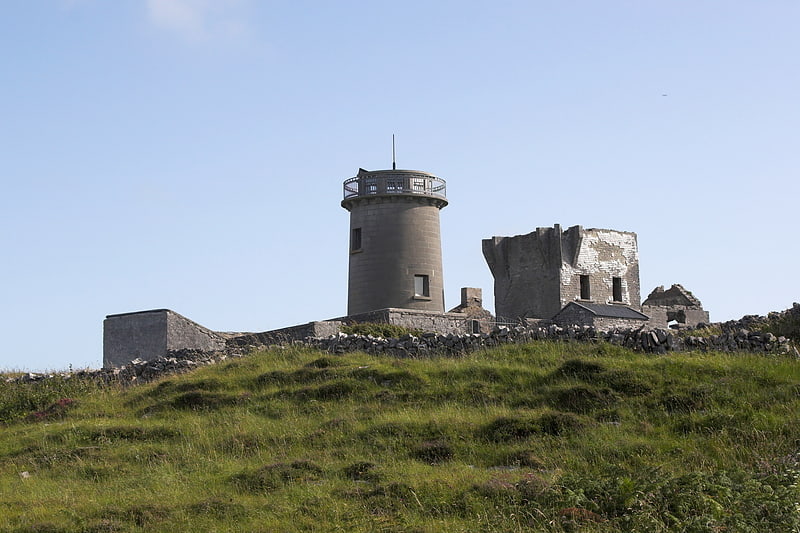
Lighthouse. The Inishmore or Dún Árann Lighthouse, is a decommissioned lighthouse located on the highest point of Inishmore, the largest of the Aran Islands in County Galway, Ireland. It was the first of a series of lighthouses that were built in the 19th century on the Aran Islands, but it was poorly positioned and was eventually replaced by the Inisheer Lighthouse and the Eeragh Lighthouse. Its deactivation also resulted in the construction of another lighthouse on Straw Island.[37]
Clare Museum, Ennis

Museum in Ennis, Ireland. Clare Museum is a museum which documents the history of County Clare. The museum is housed in the former Sisters of Mercy Convent in the centre of Ennis.[38]
Cobh Heritage Centre, Cobh
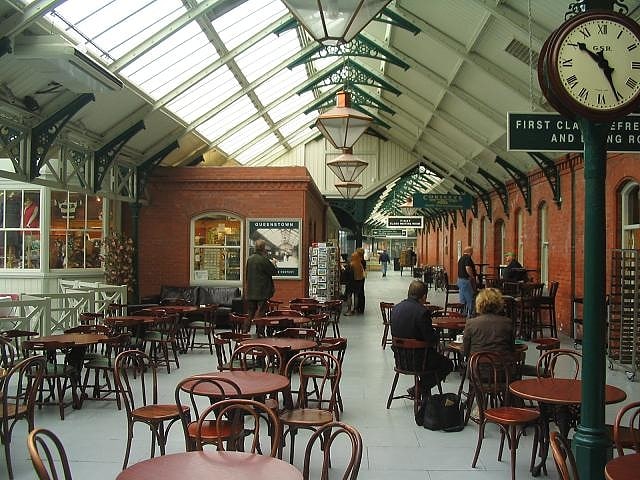
Museum in Cobh, Republic of Ireland. The Cobh Heritage Centre is a museum located in Cobh, County Cork, Ireland. It is attached to Cobh railway station.
The "Queenstown Experience", located at the centre, has mostly permanent exhibitions of Irish history. It has held exhibits on life in Ireland through the 18th and 19th centuries, mass emigration, the Great Famine, on penal transportation to Australia, and on the sinking of the RMS Lusitania. It also has an exhibition on the history of the RMS Titanic, whose last port of call before it sank was Cobh (then Queenstown).
The centre is a tourist destination, including with visitors from cruise ships, which often dock in Cobh. The centre has two onsite gift shops and a café.[39]
Address: Lower Road, Cobh
James's Fort, Kinsale

James Fort is an early 17th-century pentagonal bastion fort located on Castlepark peninsula in Kinsale harbour, County Cork, Ireland. Situated downstream from Kinsale on the River Bandon, the fort was built to defend the harbour and seaborne approaches of the town. Following the construction of Charles Fort on the opposite side of the harbour in the late 17th century, James Fort became known as the "old fort". Listed as a protected National Monument, and managed by the Office of Public Works, the fort is open to visitors.[40]
Cathedral of the Immaculate Conception, Sligo
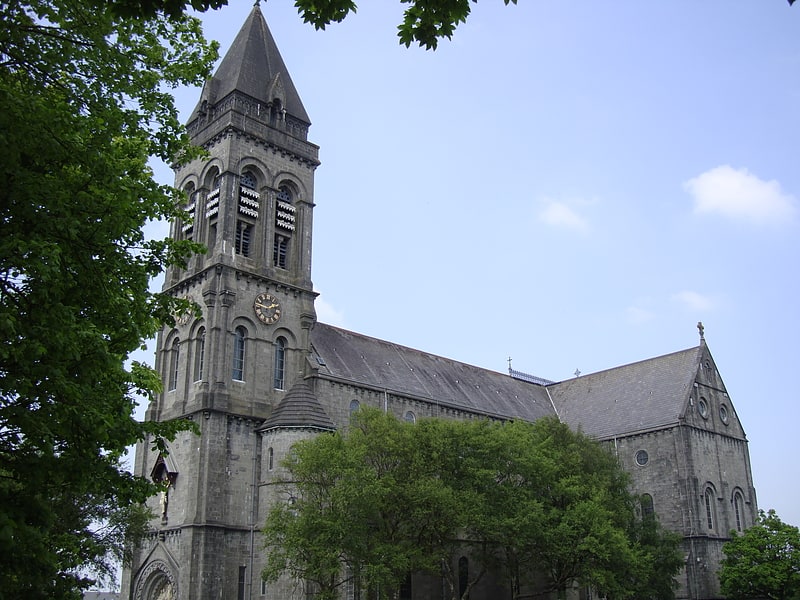
Cathedral. The Cathedral of the Immaculate Conception is the cathedral church of the Roman Catholic Diocese of Elphin. It is located on Temple Street in Sligo, Ireland. The cathedral was developed by Bishop Laurence Gillooly who had been appointed Bishop of Elphin in 1858. He decided that the diocese was now of a size and wealth that the time had come to replace St. John's Parish Chapel, which had been recognised as the diocesan pro-cathedral.
He engaged George Goldie, one of the foremost Catholic architects in England in the nineteenth century. The cathedral was opened for divine worship on 26 July 1874 by Cardinal Paul Cullen of Dublin.
Modelled on a Normano–Romano–Byzantine style, it is the only example of a Romanesque style cathedral built during the 19th century. Designed in the shape of a basilica, the church has a square, pyramid-capped tower, which reaches a height of 70 metres, and supporting turrets at the west end. It can seat 1400 people. The circular baptistery incorporated in the apse with its five lancet windows behind the high altar, was originally designed as a mortuary chapel.[41]
Address: John Street, F91 CF59 Sligo
Dundalk Stadium, Dundalk

Stadium in the Republic of Ireland. Dundalk Stadium is a horse and greyhound racing venue in Ireland. It is located to the north of Dundalk in County Louth.
The total build cost €35million with a modern grandstand, elevated viewing areas, restaurant and bars.[42]
Address: Racecourse Road, Dundalk
Dowth, Brú Na Bóinne Archaeological Park
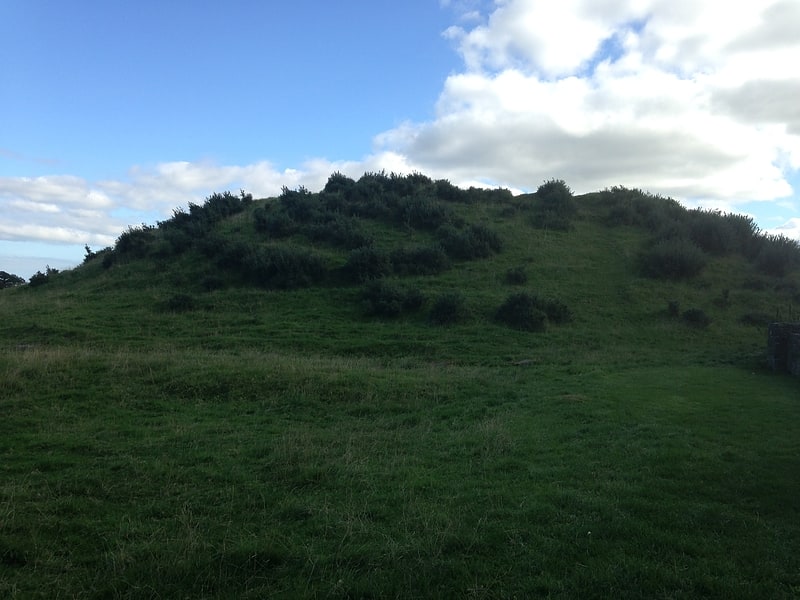
Historical landmark in the Republic of Ireland. Dowth is a Neolithic passage tomb located in the Boyne Valley, County Meath, Ireland. It is one of the three principal tombs of the Brú na Bóinne World Heritage Site – a landscape of prehistoric monuments including the large passage-tombs of Dowth, Newgrange and Knowth. Unlike Newgrange and Knowth, Dowth has not been independently dated, but its features align it with the other passage tombs which date from between approximately 3200 and 2900 BC. However, Harbison dates the tomb at 2500 – 2000 BC. It is less developed as a tourist attraction than its neighbours, partly because the chamber is much lower, and partly because the decoration is less visible. It was partly excavated, in 1847 by the Royal Irish Academy who dynamited the roof causing the still visible crater, though it was pillaged by Vikings and earlier looters long before that.
Archaeological and geophysical field surveys of the entire site, including later monuments, were carried out episodically from 2012-2015. In July 2018, another passage tomb in the grounds of nearby Dowth Hall was excavated, revealing significant examples of Neolithic rock art similar to those at Dowth and the other Brú na Bóinne sites.[43]
Waterford Museum of Treasures, Waterford

Museum in Waterford, Republic of Ireland. The Waterford Museum of Treasures is a museum for historical artifacts associated with the city of Waterford. There are three museums in the Viking Triangle collectively known as Waterford Museum of Treasures. Its collection includes the 14th Century Waterford Charter Roll.[44]
Address: Cathedral Square, X91 K10E Waterford
Cobh Museum, Cobh
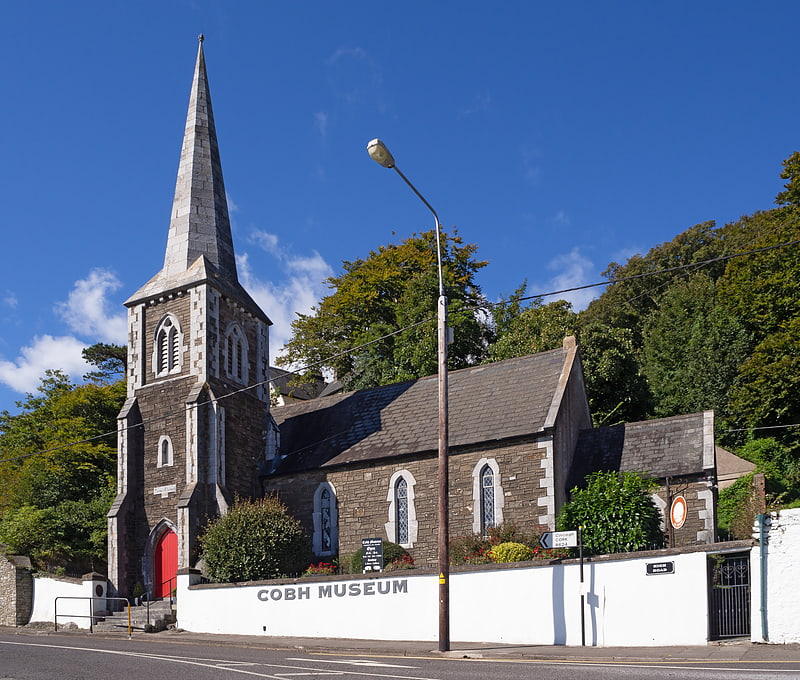
The Scots Church is a former Presbyterian church in Cobh, Ireland. It is today a museum, the Cobh Museum, which tells the history of the town.[45]
Address: Scots Church, High Rd, Cobh
Mullingar Greyhound Stadium, Mullingar

Stadium in Mullingar, Republic of Ireland. Mullingar Greyhound Stadium is a greyhound racing track located in south Mullingar in Ireland. The stadium has a grandstand restaurant, a fast food outlet and a number of bars. Racing takes place on a Saturday evening at 7.30pm and early Sunday afternoon.[46]
Address: Lynn Rd, N91 P22Y Mullingar
Irish Agricultural Museum, Wexford
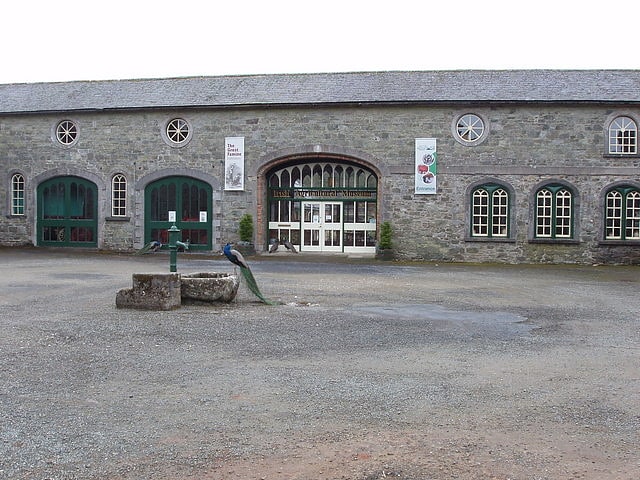
Museum in the Republic of Ireland. The Irish Agricultural Museum is a museum dedicated to the history of Irish rural life. Housed in the farm buildings of Johnstown Castle, County Wexford, the collections represent all elements of rural life, including transport, crafts, farming activities and dwelling.[47]
Address: Oldtown Ln, Wexford
Mellifont Abbey, Drogheda
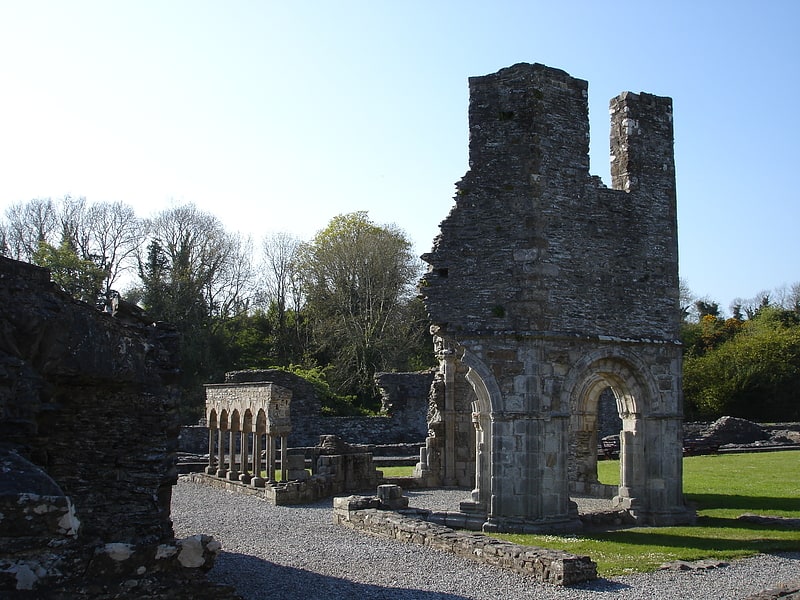
Monument in Tullyallen, County Louth, Ireland. Mellifont Abbey, was a Cistercian abbey located close to Drogheda in County Louth, Ireland. It was the first abbey of the order to be built in Ireland. In 1152, it hosted the Synod of Kells-Mellifont. After its dissolution in 1539 the abbey became a private manor house. This saw the signing of the Treaty of Mellifont in 1603 and served as William of Orange's headquarters in 1690 during the Battle of the Boyne.
Today, the ruined abbey is a National monument of Ireland and accessible to the public. The English language name for the monastery, 'Mellifont', comes from the Latin phrase Melli-fons, meaning 'Font of Honey'.[48]
Address: Old Mellifont Rd, Drogheda
Irish National Heritage Park, Wexford
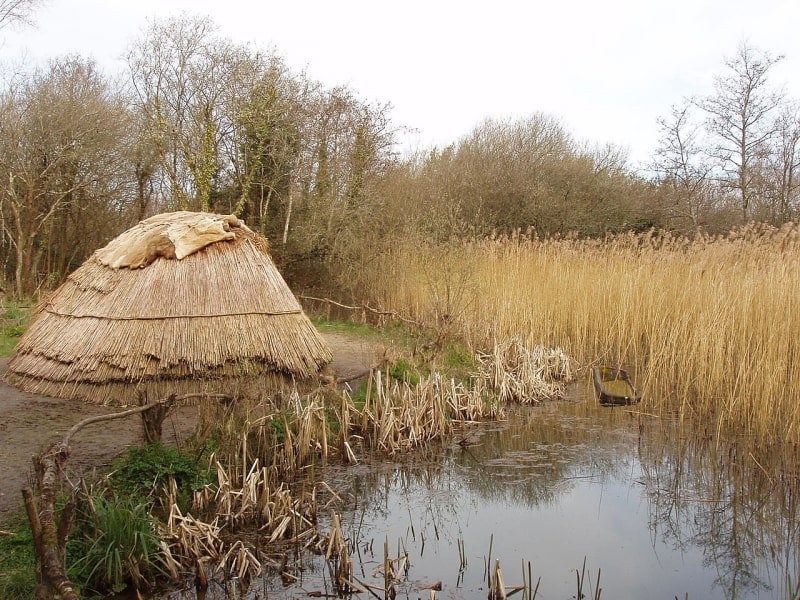
Museum in the Republic of Ireland. The Irish National Heritage Park is an open-air museum near Wexford which tells the story of human settlement in Ireland from the Mesolithic period right up to the Norman Invasion in 1169. It has 16 reconstructed dwellings including a mesolithic camp, a neolithic farmstead, a portal dolmen, a cyst grave, stone circle, medieval ringfort, monastic site, crannóg and a Viking harbour. It opened in 1987 and opens 363 days of the year to the public. It covers 35 acres of parkland, estuary trails and wetland forest. It is a not for profit organisation and all its receipts from admissions, restaurant and shop sales go directly back into the running and maintenance of the park.
The park offers guided tours led by costumed guides, have audio guides available or self guiding options. The guided tour lasts about one and a half hours and ends at the Viking harbour. The park also contains a restaurant and a gift shop. The Trials of Tuan are a set of fun activities throughout the park for children to enjoy culminating in panning for gold.[49]
Address: Irish National Heritage Park, Y35 X313 Wexford
Raheen-a-Cluig, Bray
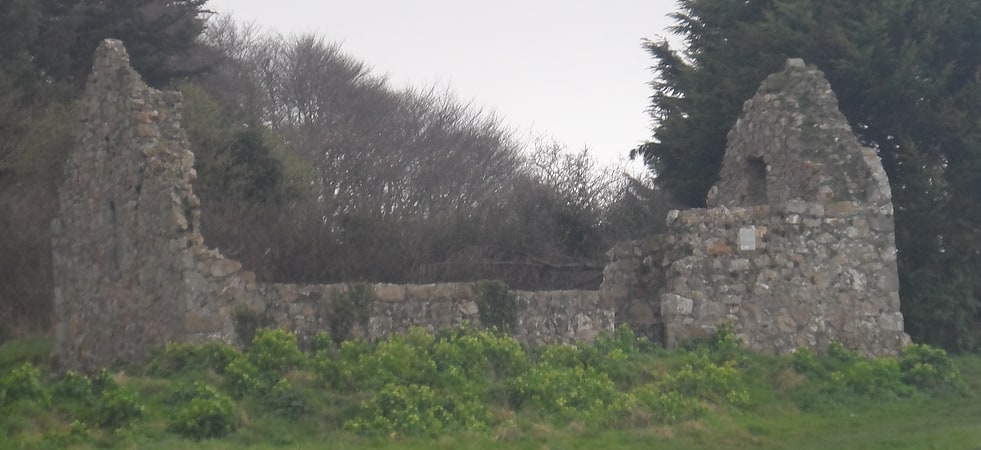
Tourist attraction in the Republic of Ireland. Raheen-a-Cluig is a medieval church and National Monument in Bray, County Wicklow, Ireland.[50]